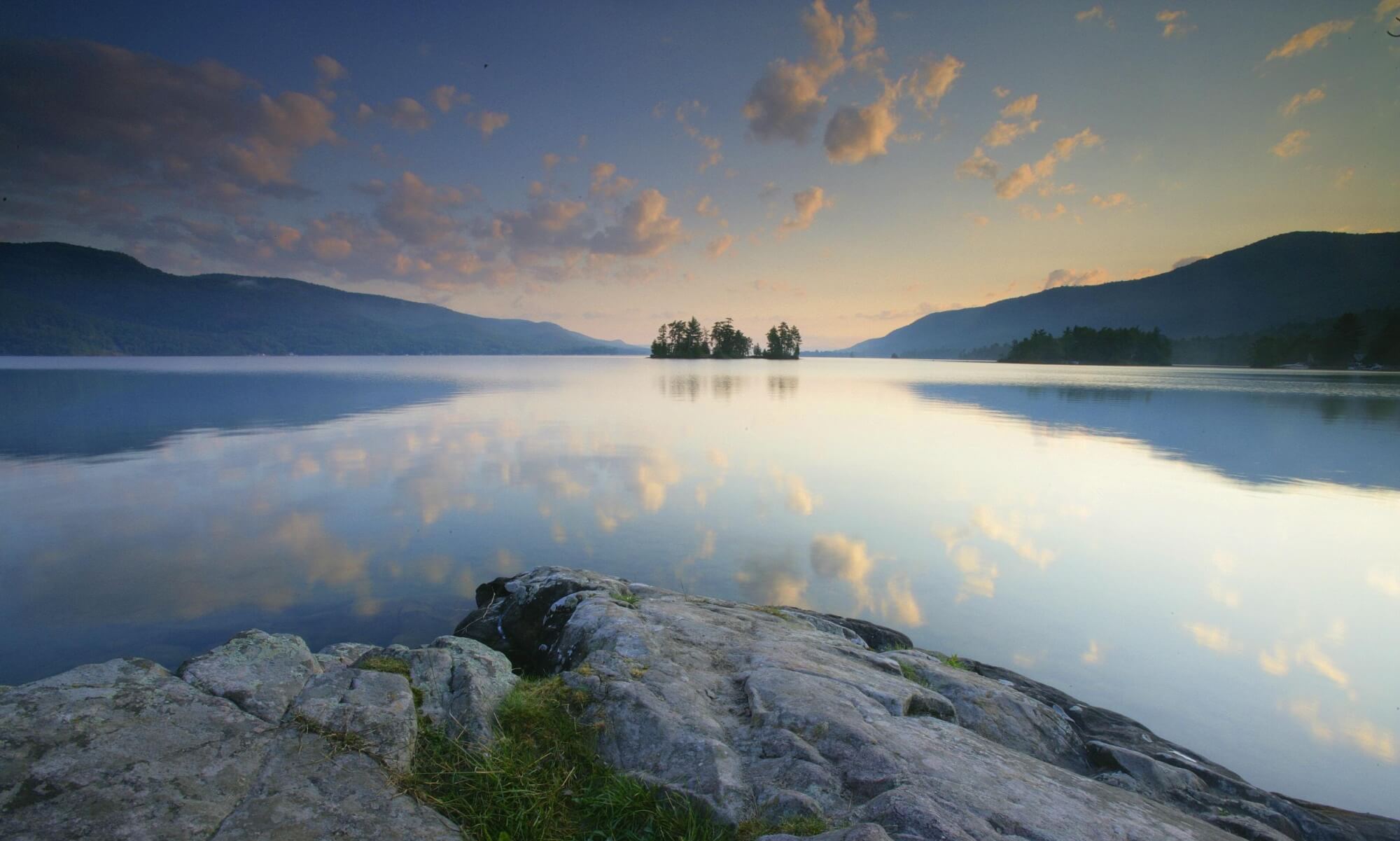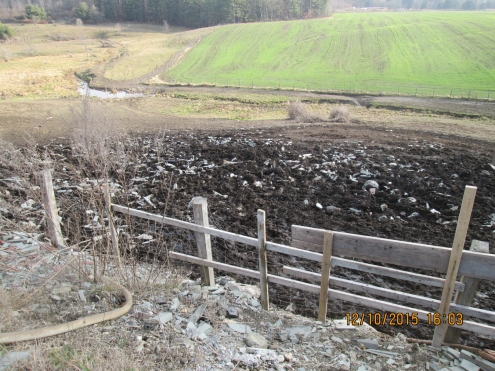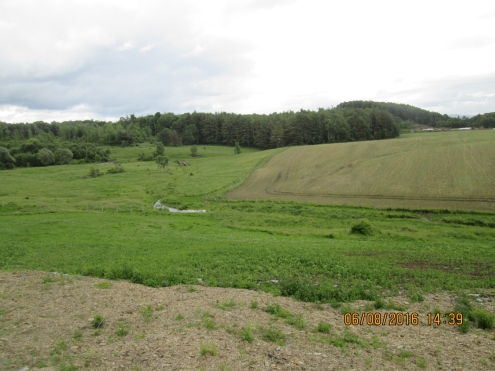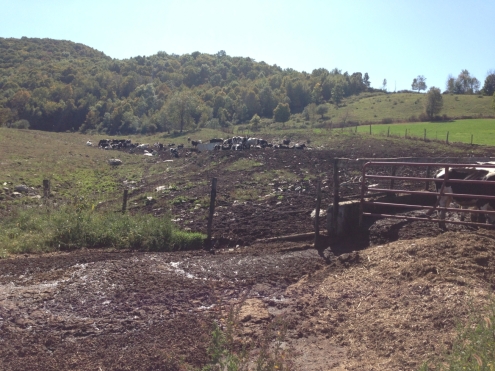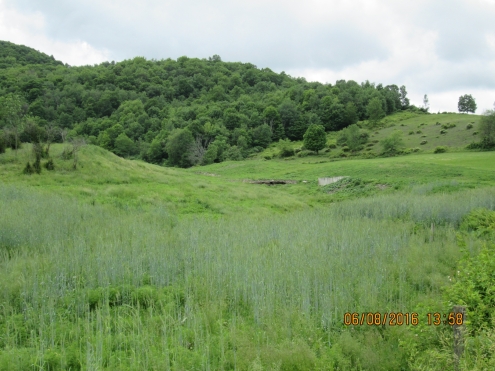The Lake George Park Commission has released the 2016 Lake George Aquatic Invasive Species Prevention / Boat Inspection Program Report. 2016 was the busiest year to date under the program, with a fairly significant increase in the number of boater contacts over the previous two years due to the fantastic weather this past summer. (Click image to read.)
LGPC Boat & Dock Fees to Increase in 2017
 The Lake George Park Commission has received approval from the state legislature to raise dock, mooring and boat fees in 2017. From the bill authorizing the increase:
The Lake George Park Commission has received approval from the state legislature to raise dock, mooring and boat fees in 2017. From the bill authorizing the increase:
Dock, wharf and mooring fees. The owner of a dock, wharf or mooring within the park used for non-commercial residential purposes shall pay an annual fee of fifty dollars. The owner of a dock or wharf within the park used for commercial purposes shall pay an annual fee of five dollars per linear foot for each such dock. The owner of a mooring used for commercial purposes shall pay an annual fee of one hundred dollars for each mooring. New docks constructed for commercial use after the effective date of this section shall pay a first time fee of ten dollars per linear foot and five dollars per linear foot annually thereafter.
Boat fees. In addition to the registration required by the state, any mechanically propelled boat or vessel with ten horsepower or more used on Lake George shall have an annual permit issued by the commission. The fee therefor for boats twenty feet or less in length overall shall be forty dollars; for boats twenty-one to twenty-five feet in length overall, fifty dollars; and for boats over twenty-five feet in length overall, fifty dollars plus seven dollars and fifty cents for each foot by which the length overall exceeds twenty-five feet; for boats over twenty-five feet in length overall outfitted for overnight use, fifty dollars plus thirty dollars for each foot by which the overall length exceeds twenty-five feet. The commission may establish a one week use permit for twenty dollars. The commission may establish a one day use permit for twelve dollars for any mechanically propelled boat or vessel with ten horsepower or more.
Little Red Seaplane Flyby

Neal Vandorsten sits in the cockpit of a small seaplane he flew up Lake George last week.
The aerial photo I posted on Thanksgiving day inspired Neal Vandorsten to pass along these two shots from a small red seaplane he piloted up Lake George last week.

The lake was calm on a clear autumn day.
Many thanks to Neal for passing along these photos.
Happy Thanksgiving (from the Air)
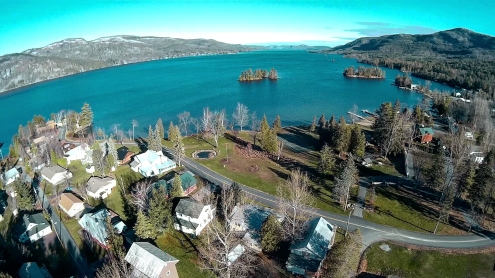 An aerial view of Huletts, taken on Wednesday November 23, 2016. (Click to see full-scale.)
An aerial view of Huletts, taken on Wednesday November 23, 2016. (Click to see full-scale.)
While you are hopefully celebrating with family and friends today, here is an aerial view of the Landing, taken from above the Casino, looking north up Lake George. Our heartfelt good wishes go out to you and your family on this Thanksgiving day. (Many thanks to Lloyd Ballantyne for the photo.)
LGLC Takes Steps Towards Completing Vision of Protection in Putnam
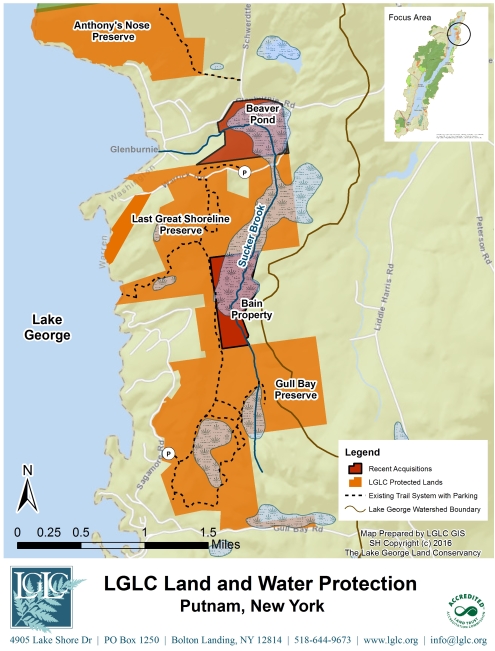
The Lake George Land Conservancy (LGLC) recently acquired 72 acres in the Town of Putnam from Thomas and Mary Ellen Eliopoulos. The land, known as the Beaver Pond property, joins another 65 acres purchased from the Bain family in September as the latest additions in a focused effort to protect the 2,000-acre watershed of Sucker Brook, a major tributary of Lake George.
As one of Lake George’s ten largest tributaries, Sucker Brook drains directly into the lake at Glenburnie, and makes a significant impact on the lake’s water quality. Its protection provides a safeguard against excess storm water runoff, erosion of the stream corridor, and nutrient loading from neighboring sources of fertilizers and road salt, further protecting the lake’s water quality.
“We have wanted to protect these properties for a very long time,” said LGLC Executive Director Jamie Brown, “and are grateful for the support of the local community, including the residents of Glenburnie, for helping to make the projects happen.”
“The landowners shared the LGLC’s vision of seeing this environmentally-sensitive property protected,” Brown continued, “to ensure that it would help to keep the waters of Lake George clean forever.”
Both the Beaver Pond and Bain properties primarily consist of wetlands, which help to filter and slow the waters of Sucker Brook before entering Lake George. Specifically, beaver ponds have been shown to be particularly beneficial for water quality. Studies indicate that these ponds can trap and remove nearly 50% of excess nitrogen from the water. High levels of nitrogen, resulting from chemicals like lawn fertilizers being carried downstream in storm water, can trigger algal blooms and fish kills.
Generally, protected land also provides thousands of dollars in natural resource benefits to the community each year in the form of storm water protection, aesthetic value, habitat, and pollution control. In addition, properties such as this one are open to the public for everyone to use and enjoy for multiple purposes, including hiking, snowshoeing, cross-country skiing, bird-watching, and hunting.
Growing Recreational and Educational Opportunities
The location of these properties allows for an extended public recreational trail corridor. Between the LGLC’s Gull Bay Preserve on Sagamore Road and the peak of Record Hill on Anthony’s Nose, the region currently includes 7.5-miles of marked trails, including ½-mile newly added to show off the Bain property’s unique white cedar swamp. An additional 1 mile of trail on the beaver pond property is proposed, which would also connect to the Anthony’s Nose trailhead.
Nine educational panels have been installed along the region’s existing trails, with information about nocturnal wildlife, hardwood forests, wetlands and more. Future plans include additional signage, as well as the construction of bridges or boardwalks with viewing platforms through the wetland and beaver pond areas.
The entire system will be a draw for school groups, birders, and other guests may observe the plants and animals that are present, while at the same time gain a better understanding of how the land functions to protect the water.
Altogether, the region between Glenburnie and Gull Bay Roads offers 925 acres of contiguous protected land. Due to the complexity of having so many different parcels, the LGLC plans to merge all of the properties together to create one cohesive preserve. A revised trail map and other resources are expected to be completed for the 2017 summer season.
This project, as well as other efforts north of Anthony’s Nose, are ongoing, and the LGLC welcomes support from the community and interested individuals who wish to help financially, or with the research and creation of additional educational materials. Schools and other community groups interested in having a guided field trip to the area are also welcome and encouraged to contact the LGLC’s Communications and Outreach Manager Sarah Hoffman at 518-644-9673 or email shoffman@lglc.org.
Thanksgiving Weekend Weather
If you’re planning on heading up to Huletts for the Thanksgiving weekend, most of the snow missed us. We had less than 1/2 an inch. It looks like it will be cold with some snow coming on Thursday. So if you’re headed this way – please bundle up.
Whiteface First Snow
Carl Heilman 2017 Calendars Have Arrived at LGA

If you are a fan of stunning Lake George visuals, the Lake George Association has some exciting news to share with you — especially if you are looking to keep Lake George in your sight all year round.
The 2017 edition of Carl Heilman II’s Lake George calendar is going on sale. As always, the images are stunning.
The calendar sale raises money that is put toward the Lake George Association’s Lake-Saving Projects — so purchasing the calendar from the Lake George Association allows you to view the Lake through Carl Heilman II’s dramatic eyes and helps the LGA protect the Lake’s water quality, too!
You can pick up your Carl Heilman II calendars at the LGA office for $16, or for just $1 more ($17) it can be mailed to you.
Don’t delay — these calendars always sell out fast!
To purchase your copies of the 2017 Lake George calendar (or order them to be sent to you), please call Mona at 518-668-3558 or email: info@lakegeorgeassociation.org.
LGLC Fall/Winter 2016 Newsletter
LGLC Names Two New Board Members

George Morris (left) and James W. Wolitarsky (right) recently were appointed to the Board of the Lake George Land Conservancy.
The Lake George Land Conservancy (LGLC) recently announced the recent addition of two new directors to its Board, George Morris and James W. Wolitarsky.
“We are very excited to have Jim and George join our Board,” said LGLC Executive Director Jamie Brown. “Both bring to the LGLC strong leadership skills, a commitment to our mission, and a rich and deep connection to Lake George. It’s been great getting to know these two new Directors, hearing about their ideas, their stories about time spent on the lake, but mostly their enthusiasm for protecting the land that protects this special place. We extend a warm welcome to our newest Directors and look forward to the impact that they will make on LGLC and the lake.”
George Morris recently finished his 31st year with Oliver Wyman, the international management consulting firm and part of Marsh and McLennan, where he is a Partner in the Financial Services group based in New York City. His consulting career began after graduating with an MBA from the University of Chicago Graduate School of Business (1985) and an AB from Dartmouth College (1980). In 2016 he co-authored a paper on risk management for non-profits based on financial analysis of charities in New York State. Now, he is semi-retired and leads the firm’s Social Impact initiative out of the New York office and contributes to developing future generations of world-class management advisors.
Mr. Morris resides in Pilot Knob, NY, and is a third generation lover of Lake George. His lake experience began at his parents’ house, also known as “Flower Down”, in the Town of Lake George. Mr. Morris is a hiker and forager, loves sailing, early morning boat rides, and kayaking. He’s a second generation member of the Lake George Club and raced sailboats there for many summers.
James (Jim) W. Wolitarsky is the former President and Chief Executive Officer of Janney Montgomery Scott LLC, a major U.S. east coast full-service financial services firm headquartered in Philadelphia, PA. Jim joined the company in 1991 as its Chief Financial Officer. He was elected President and Chief Operating Officer in January 2000 and Chief Executive Officer in January 2001. He also served as Chairman of its Executive Committee.
Jim received a B.A. degree in 1968 from Franklin & Marshall College, Lancaster, PA and earned a M.B.A. degree in 1973 from New York University. He served in the United States Army as a sergeant from 1968 to 1970 with service in Vietnam and was decorated with a Bronze Star and Vietnam Cross of Gallantry.
Mr. Wolitarsky is currently a board manager of Pennsylvania Hospital, a core member hospital of the University of Pennsylvania Health System; a director of D.A. Davidson Companies, a full-service regional securities broker-dealer doing business in the western United States and a director of Pennsylvania Trust Company. He has served on many boards, including as Vice Chairman and Treasurer for the FUND for Lake George, and has lectured nationally and participated in a wide array of financial conferences and forums.
Mr. Wolitarsky first came to the lake when he was 5 or 6 years old and then spent every subsequent childhood summer for 2 or 3 weeks with his family at a rented lakeside cottage on Black Point Road in Ticonderoga. He and his wife, Nini, bought their current home on the lake in 2006. Jim and Nini live in Villanova, PA, and have four children.
Washington County Soil & Water Conservation District Explained
As everyone knows, Washington county is a large county with much of its total acreage dedicated to farming and dairy production. I like to occasionally spotlight things going on in the county that might be of interest. Today, I wanted to explain what the Washington County Soil & Water Conservation District (SWCD) does.
The Washington County Soil & Water Conservation District (SWCD) is a unique unit of local government that was founded in 1945. Their mission is to assist agricultural producers, rural landowners and municipalities with the management, conservation and best use of our natural resources. In plain terminology – they protect the County’s soil and water resources while maintaining the viability of agriculture as a preferred land use.
In that regard, I subscribe to their newsletter which spotlights what they do in the county. Recently, they published an article which focused on their work at a nearby farm which I found interesting and which the SWCD gave me permission to reprint here. Red Top farm is located in Granville, NY.
Ag Non-Point Source Grant – Round 20 – Red Top Farm
By Ben Luskin, Natural Resource Technician
Last Autumn Red Top Dairy completed a bedded pack waste storage and transfer system. All of the farm’s heifers were moved into the system where manure and feed nutrients are contained and controlled. The engineered system was put into place with the help of the Soil and Water Conservation District (SWCD) because the heifers were being fed on concrete pads with no curbing or roof structures to control clean or dirty runoff. The 340 Animal Units were allowed free access to the entire stream corridors in the pastures; polluting the watercourse, eroding stream banks, and denuding vegetation. The feeding areas in both locations were upslope from Class C(T) trout tributaries to the Mettawee River.
This Spring the heifer facilities, Diplock and Red’s House, where the livestock were previously housed were remediated. Concentrated manure from the feeding and loafing areas was scraped up and spread on farm fields that needed the nutrients. All of the headlocks and concrete infrastructure used for feeding at the Red’s House facility was removed and disposed of. The equipment crossing at Diplock’s was renovated by installing an adequate culvert, cleaning out sediment deposition at the inlet, and constructing large headwalls at the inlet and outlet. Both sites were graded and shaped to stable more attractive slopes which involved trucking in additional clean fill when on site material was not available. Farm equipment was used to prepare a good seed bed before Car-O-Vail came to broadcast the seed. The farm ensured seed to soil contact by cultipacking the acreage. Areas along the stream that were hard to access with equipment were hand seeded by the SWCD. For now, both facilities will remain vacant but the farm looks forward to working with the SWCD to develop grazing plans on each site that will supply vegetation to a suitable amount of heifers, while protecting the areas natural resources.
Click all images to see full-scale.
Administrators Note: Many thanks to the Washington County Soil & Water Conservation District for their permission to reprint their article and pictures here.
LGLC Protects Wetlands in Putnam to Protect Lake George

Map of Bridge the Nose Initiative (Click image to see larger view.)
The Lake George Land Conservancy (LGLC) has acquired 65 acres in the Town of Putnam from Thomas and Christine Bain. The land contains important wetlands and includes a significant part of the Sucker Brook marsh, which drains directly into Lake George at Glenburnie.
The acquisition also protects a large area of rare northern white cedar swamp. This habitat type is threatened State-wide by development, habitat alteration, and recreational overuse, as well as invasive species, such as purple loosestrife and reedgrass.
“Sucker Brook and its marsh have been a part of my family for five generations,” said Thomas Bain. “Purchased by my Great Grandfather around 1945 it has been enjoyed by generations of the Bain Family down through my children. The serenity and quiet beauty of that location is treasured by myself and my extended family. I can recall hiking through the marsh in the middle of winter as a boy and being amazed by the stark contrast of the rich jet black mud bottom of Sucker Brook to the surrounding bright white snow.”
“Knowing that it is protected,” Bain continued, “and in turn offers a small portion of protection to Lake George into which it runs, gives me great satisfaction. My family and I enjoy our visits to Putnam and always stop and take in the grand views of Lake George from Gull Bay or Glen Bernie. Keeping the lake in a pristine condition is essential to maintaining that beauty. The Lake George Land Conservancy has allowed us to contribute to maintaining that legacy for many generations to come.”

Photo of Lake George, South from Record Hill/Anthony’s Nose © Carl Heilman, II (Click image to see larger view.)
“The Bains have been respectful caretakers of this land for generations and understand its important connection to protecting the lake,” said LGLC Executive Director Jamie Brown. “We are extremely grateful to them for their conservation ethic and for working with us on this important protection project. This really is a clear example of working with a landowner who understands how important the land is what we are talking about when we say protecting the land to protect the lake.”
The acquisition is part of the LGLC’s Bridge the Nose Initiative, which will allow the LGLC to complete its ten-year effort to conserve the 2,000-acre Sucker Brook complex in order to protect the water quality of Lake George, connect existing lands protected by the LGLC and New York State for recreation and wildlife, and conserve the region’s rare northern white cedar swamp ecosystem.
Sucker Brook is one of Lake George’s ten largest tributaries, which means that the water flowing through it may significantly impact the lake’s water quality. Its protection by the LGLC provides a safeguard against excess storm water, erosion of the stream corridor, and nutrient loading from neighboring sources of fertilizers and road salt, further protecting the lake’s water quality.
This most recent acquisition is adjacent to the LGLC’s Gull Bay and Last Great Shoreline Preserves, filling in a gap between the properties. The LGLC expects to extend the preserves’ trail systems to include a strategically placed boardwalk along or through the northern white cedar swamp with wildlife viewing platforms.
Survival Skills Theme for LGLC’s 2nd Annual Kids’ Scavenger Hunt and Hike

Group of youth and parents enjoy the view at the top of the Pinnacle during the LGLC’s Scavenger Hunt and Hike event.
The Lake George Land Conservancy (LGLC) hosted its 2nd annual scavenger hunt and hike for kids on Tuesday, July 26. Designed by 15-year-old Jahnavi Bhavsar of Huletts Landing, this year’s hike focused on wilderness survival skills.
Starting with a brief lesson in map reading led by volunteer Todd Earl, the group of 23 youth and a parents were divided into teams before heading for the trail at The Pinnacle Preserve in Bolton Landing. The Pinnacle, which is owned by the Town of Bolton and managed by the LGLC, was protected through a unique partnership between the LGLC, the Town of Bolton, and the Fund for Lake George in 2015.
The teams encountered trivia questions along the trail that tested their knowledge in hiking safety and wilderness survival. Lunch at the summit concluded with an additional challenge of finding a list of edible and poisonous plants in the woods and along the trail on their descent. Prizes were awarded and everyone cooled off with some ice cream from Ben and Jerry’s, where they all were able to look up at the Pinnacle peak from the front porch.
Bhavsar has big plans for 2017, including a shelter building challenge and animal tracking at the LGLC’s Amy’s Park. The date for this free event is to be determined, but those interested may contact Helen Barton Benedict at hbartonbenedict@lglc.org or check lglc.org for updates
Froehlich Foundation Grants LGLC Over $200,000 Toward Conservation Projects
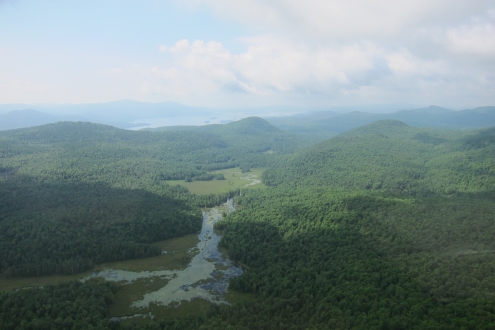
An aerial view over the wetlands of Amy’s Park, which is a major part of the Indian Brook watershed. The peak in the middle is Pole Hill; on the right is High Nopit, and on the far left is Walnut Ridge. Walnut Ridge is part of the New York state Pole Hill Pond Forest Preserve, and the future Isabel La Roche Godwin Preserve lies adjacent, to the east. (View southeast toward Bolton, (near side of lake) and Diamond point, (opposite side of lake).(Click image to see full-scale.)
The Lake George Land Conservancy (LGLC) has received a grant of $200,250 from the Helen V. Froehlich Foundation in support of focused conservation projects and initiatives that will help protect the land that protects the lake forever.
The grant will be used on priority projects highlighted within the LGLC’s recently adopted Strategic Plan, which focuses on core conservation values that include: community partnerships to protect land and places that are important to the people who live and play in Lake George; and projects that protect land vital to protecting the water quality of Lake George as well as provide recreational opportunities, and protect habitat, viewshed, and historical and cultural resources.
Of the amount received, $82,000 will be used to support land protection efforts within the relatively undeveloped area of the Indian Brook watershed in Bolton.
An additional $82,000 will go towards several key parcels on the northeastern shore of the lake that will link the proposed ridgeline trail along South Mountain to the LGLC’s Last Great Shoreline and Gull Bay Preserves. New properties will also be added to the Preserves, increasing the acreage of protected wetlands and tributaries so as to protect water quality, as well as important wildlife habitat and hiking trails.
The LGLC is currently working to conserve a total of 470 acres in these two regions that will result in the immediate protection of the water quality of Lake George, as well as provide better access to state protected land, link trail systems, preserve a wetland complex, and create additional recreational opportunities. By working with willing landowners to ensure that sensitive lands are protected forever, the LGLC is making a substantial, lasting impact on the water quality of Lake George.
An additional $36,250 will enable LGLC staff to further the organization’s mission. The staff are responsible for managing over 35 miles of trails, monitoring easements, and working with landowners to protect sensitive lands.
“We are so grateful to the Froehlich Foundation for its generous support of our work,” stated LGLC Executive Director Jamie Brown. “They have been an important part of what we do for a long time, and helped us to make a real impact on the protection of Lake George They are making a real difference.”
The Helen V. Froehlich Foundation was created in 1993 with funds provided by the late Helen V. Froehlich to assist with the conservation and preservation of Lake George. The Lake George Land Conservancy is just one of several local organizations that benefit from the Foundation’s generosity. This most recent gift is the 22nd consecutive grant awarded to the LGLC by the Froehlich Foundation, a total of over $3 million.
